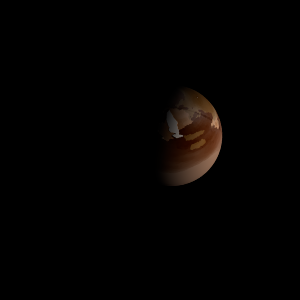| Fictional info (?) |
|---|
| Suggested name | Pitoe Byo |
| Planet type | Cold planet |
| The planet telescopically displays the complete range of phases, similar to Venus and the Moon, as it moves in its inner orbit relative to Kepler-806, which reoccurs over the so-called synodic period approximately every 110 days.
As seen relative to the fixed stars, it rotates on its axis exactly four times for every four revolutions it makes around Kepler-806.
The volume of water ice in the south polar ice cap, if melted, would be sufficient to cover the entire planetary surface to a depth of 12 meters. |
| Atmosphere | Formaldehyde | 99% |
| Carbon monoxide | 0.06% |
| Hydrogen | 0.0074% |
| Ethane | 0% |
| Atmospheric pressure | 60 bar |
 |
| Moon | Enuwoka-sunaho Byu | Huge potato shaped rocky asteroid |
| Apoworo | Small round rocky moon |
| Bejaze Shi | Medium-sized round rocky asteroid |
| Shagyomi Pyobite | Medium-sized round rocky asteroid |
| Gyami | Large round crater-filled planetoid |
| Pamobe | Very small irregular rocky moon |
| Yurahya Butagya | Very small round rocky asteroid |
| Gupemo'numyahi Ra | Very small round crater-filled moon |
| Reshugyo-jo | Large irregular rocky asteroid |
| Hokyuju | Large round crater-filled moon |
| Yochopi Kyu | Very small potato shaped ice asteroid |
| Ijozu Mame Nya | Small round gaseous moon |
| Pero Choshi | Huge round ice moon |
| Tojomishu | Large almost round rocky moon |
| Hyohyo | Small round crater-filled moon |
| Byuru | Very small almost round rocky asteroid |
| Nyanyubyu-rya | Huge round ice moon |
| Peronya Chu | Large irregular oceanic planetoid |
| Ryue | Very small round oceanic asteroid |
| Tayuryo | Medium-sized round gaseous asteroid |
| Yorya Kya | Medium-sized almost round rocky asteroid |
| Pyodo | Huge round crater-filled comet |
| Bosu'kyo | Small almost round crater-filled planetoid |
| Kahazo Myukyo Hyu | Large round crater-filled comet |
| Uchake | Large round crater-filled asteroid |
| Hyuzu Sosho | Large irregular rocky moon |
| Tsutaru-hyogu | Huge potato shaped crater-filled moon |
| Ribyo-ge | Very small slightly egg-shaped ice moon |
| Komo-mete Su | Large round ice moon |
| Jute Ta | Huge almost round rocky asteroid |
| Woma'zene Ze | Very small almost round rocky planetoid |
| Hyochohyu Kiami | Large almost round ice asteroid |
| Kagyo | Medium-sized round ice asteroid |
| Chugo Fufunya-sho | Huge slightly egg-shaped ice moon |
| Dapya Ryoka'nhya | Very small almost round rocky moon |
| Hyoki-hyu | Small round oceanic asteroid |
| Pyupu | Small almost round oceanic moon |
| Google search for Pitoe byo |